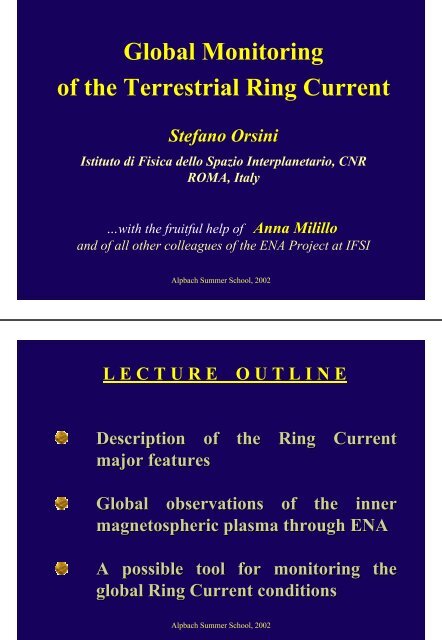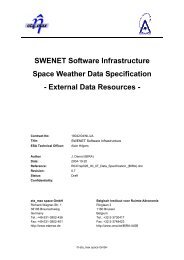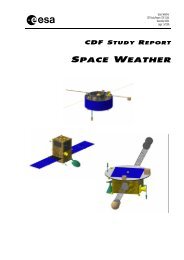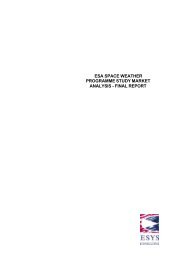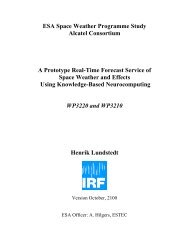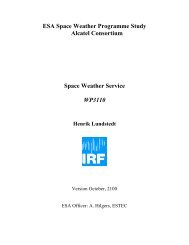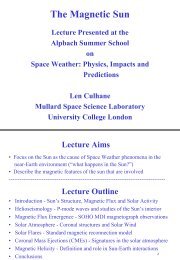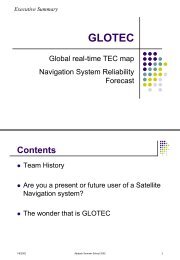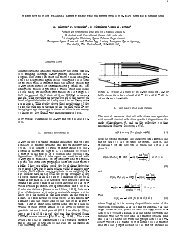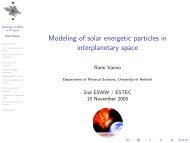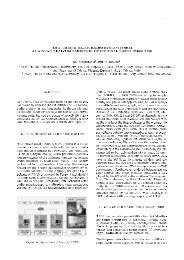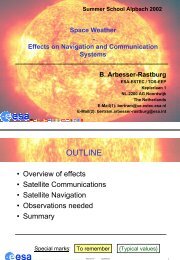Global Monitoring of the Terrestrial Ring Current - ESA Space ...
Global Monitoring of the Terrestrial Ring Current - ESA Space ...
Global Monitoring of the Terrestrial Ring Current - ESA Space ...
You also want an ePaper? Increase the reach of your titles
YUMPU automatically turns print PDFs into web optimized ePapers that Google loves.
<strong>Global</strong> <strong>Monitoring</strong><br />
<strong>of</strong> <strong>the</strong> <strong>Terrestrial</strong> <strong>Ring</strong> <strong>Current</strong><br />
Stefano Orsini<br />
Istituto di Fisica dello Spazio Interplanetario, CNR<br />
ROMA, Italy<br />
…with <strong>the</strong> fruitful help <strong>of</strong> Anna Milillo<br />
and <strong>of</strong> all o<strong>the</strong>r colleagues <strong>of</strong> <strong>the</strong> ENA Project at IFSI<br />
Alpbach Summer School, 2002<br />
L E C T U R E O U T L I N E<br />
Description <strong>of</strong> <strong>the</strong> <strong>Ring</strong> <strong>Current</strong><br />
major features<br />
<strong>Global</strong> observations <strong>of</strong> <strong>the</strong> inner<br />
magnetospheric plasma through ENA<br />
A possible tool for monitoring <strong>the</strong><br />
global <strong>Ring</strong> <strong>Current</strong> conditions<br />
Alpbach Summer School, 2002
Alpbach Summer School, 2002<br />
Processes occurring within <strong>the</strong> plasma populations <strong>of</strong><br />
<strong>the</strong> inner magnetosphere<br />
(minutes fm. ISSI Workshop on Magnetospheric Plasma Sources and Losses, 1999)<br />
Particles enter <strong>the</strong> inner magnetosphere from <strong>the</strong><br />
plasma sheet by drifting earthward across field lines, being<br />
compressed and accelerated as <strong>the</strong>y go. Particles are<br />
transported across magnetic field lines primarily by gradient<br />
and curvature drift, as well as by E x B drift in a complicated<br />
combination <strong>of</strong> potential and induction electric fields.<br />
Particles also flow along field lines from <strong>the</strong><br />
ionosphere to <strong>the</strong> magnetosphere, being accelerated upward<br />
by various small-scale plasma processes.<br />
Magnetospheric particles are lost by charge exchange,<br />
and by precipitation into <strong>the</strong> atmosphere after having <strong>the</strong>ir<br />
pitch-angles altered by wave-particle interactions or Coulomb<br />
collisions.<br />
Alpbach Summer School, 2002
Alpbach Summer School, 2002<br />
gyration<br />
Alpbach Summer School, 2002<br />
First adiabatic invariant<br />
2<br />
p⊥<br />
µ = =<br />
2mB<br />
mv<br />
2<br />
sin<br />
2B<br />
The most rapid periodic motion <strong>of</strong> a particle in a<br />
magnetic field is <strong>the</strong> gyration about <strong>the</strong> guiding center.<br />
If <strong>the</strong> field varies only on a time scale much longer than<br />
<strong>the</strong> gyroperiod and a distance scale much larger than <strong>the</strong><br />
gyroradius, gyroradius,<br />
<strong>the</strong>n <strong>the</strong> adiabatic invariant µ associated with<br />
<strong>the</strong> gyrational motion is conserved<br />
2<br />
α
Bounce<br />
motion<br />
Alpbach Summer School, 2002<br />
Second adiabatic invariant<br />
J = ∫ p//<br />
ds<br />
The particle moves up and down <strong>the</strong> field line, bouncing<br />
between mirror points in <strong>the</strong> nor<strong>the</strong>rn and sou<strong>the</strong>rn<br />
hemispheres. The adiabatic invariant J associated with<br />
<strong>the</strong> bounce motion is conserved if <strong>the</strong> magnetic field<br />
changes only on a time scale that is long compared to <strong>the</strong><br />
bounce period.<br />
Proton drift<br />
motion<br />
Electron drift<br />
motion<br />
that is much longer than Alpbach <strong>the</strong> Summer drift School, period.<br />
2002<br />
Third adiabatic invariant<br />
B × ∇H<br />
( µ , J , x,<br />
t)<br />
v D =<br />
=<br />
2<br />
qB<br />
r 2<br />
E×<br />
B µ B × ∇B<br />
p!<br />
! B × k<br />
= + +<br />
2<br />
2<br />
2<br />
B γqB 2mγqB<br />
The slowest <strong>of</strong> <strong>the</strong> three quasi-periodic quasi periodic motions is drift<br />
around <strong>the</strong> Earth. In a guiding-center guiding center bounce-averaged<br />
bounce averaged<br />
condition, <strong>the</strong> charged particle drifts across <strong>the</strong> magnetic<br />
field with a velocity vD. . The adiabatic invariant associated<br />
with <strong>the</strong> drift motion, <strong>the</strong> magnetic flux inside <strong>the</strong> drift<br />
orbit, is conserved if E and B change only on a time scale<br />
that is much longer than <strong>the</strong> drift period.
Alpbach Summer School, 2002<br />
Consider particle drift in a<br />
time-independent magnetic<br />
field, with an electric field<br />
that varies in time, though on<br />
a scale that is long compared<br />
to <strong>the</strong> gyroperiod and drift<br />
period. Assume fur<strong>the</strong>r that<br />
<strong>the</strong> gyroradius is small<br />
compared to <strong>the</strong> length scale<br />
for variations in <strong>the</strong> electric (qΦ) and magnetic (B) fields and that <strong>the</strong><br />
first adiabatic invariant is conserved and longitudinal invariant J=0. In<br />
that case, <strong>the</strong> particles mirror in <strong>the</strong> equatorial plane, <strong>the</strong>re is no<br />
curvature drift, so that:<br />
v<br />
D<br />
× ∇(<br />
qΦ<br />
+ µ B)<br />
=<br />
2<br />
qB<br />
B<br />
Electric Potential (convection + corotation)<br />
corotation<br />
Alpbach Summer School, 2002
Magnetospheric <strong>Current</strong>s<br />
Fm: C:Son Brandt, Yosemite 2002 Magnetospheric Imaging Workshop<br />
Alpbach Summer School, 2002<br />
<strong>Ring</strong> current computation<br />
v<br />
r r r r B ⎛ r P − P v v v<br />
|| ⊥ ⎞<br />
j = jr<br />
+ j + = × ⎜∇<br />
+ ⋅∇<br />
⎟<br />
∇ c jG<br />
P⊥<br />
( B ) B<br />
2<br />
2<br />
B ⎝ B isotropy<br />
⎠<br />
The three terms on <strong>the</strong> right side <strong>of</strong> <strong>the</strong> equation represent<br />
currents due to <strong>the</strong> particle pressure gradient, <strong>the</strong> magnetic field<br />
gradient and <strong>the</strong> magnetic field line curvature respectively.<br />
Induced magnetic field variation<br />
∆B<br />
B<br />
0<br />
=<br />
2E<br />
3Em<br />
According to <strong>the</strong> Dessler-Parker-Sckopke relation (Dessler and<br />
Parker, 1959; Sckopke, 1966) <strong>the</strong> disturbance <strong>of</strong> <strong>the</strong> geomagnetic field<br />
during storms is proportional to <strong>the</strong> energy <strong>of</strong> <strong>the</strong> ring current particles.<br />
Alpbach Summer School, 2002
<strong>Ring</strong> <strong>Current</strong> sources<br />
Inward transport <strong>of</strong> plasma sheet particles through<br />
enhanced convection electric field<br />
Particle injection associated with a substorm<br />
Diffusive transport <strong>of</strong> energetic particles due to <strong>the</strong><br />
magnetic/electric fluctuations<br />
Inward transport <strong>of</strong> preexisting particles due to an<br />
enhanced electric field<br />
Direct entry <strong>of</strong> ions from <strong>the</strong> polar regions<br />
charge-exchange<br />
Alpbach Summer School, 2002<br />
Loss Processes<br />
energy loss for Coulomb collisions<br />
pitch angle scattering for Coulomb collisions<br />
wave-particle interactions<br />
loss due to upper atmosphere precipitation<br />
loss in <strong>the</strong> dayside magnetopause<br />
Alpbach Summer School, 2002
Theoretical models: common procedures<br />
Simulation <strong>of</strong> particle convection<br />
Guiding-center and bounce-averaged approximation<br />
(conservation <strong>of</strong> 1 st and 2 nd adiabatic invariants)<br />
Given pitch angle distributions<br />
Stationary or slowly varying electric and magnetic<br />
field models<br />
Alpbach Summer School, 2002<br />
Two different approaches<br />
Particle-tracking codes, which follow weighted<br />
plasma packets through given electric and<br />
magnetic fields, assuming some loss time<br />
scale [e.g.: Ebihara and Ejiri, JGR, 2000].<br />
Solution <strong>of</strong> <strong>the</strong> time dependent kinetic equation<br />
for <strong>the</strong> phase-space distribution function<br />
[e.g.: Liemohn et al., JGR, 2001].<br />
Alpbach Summer School, 2002
[Ebihara and Ejiri, JGR,105, 15843, 2000]<br />
Following Cladis and Francis [JGR, 90, 3465, 1985],<br />
<strong>the</strong> spatial and temporal evolution <strong>of</strong> phase space density is<br />
solved by tracing <strong>the</strong> bounced-averaged drift trajectories <strong>of</strong><br />
packet particles which carry <strong>the</strong> number <strong>of</strong> real particles in a<br />
phase space bin.<br />
A trajectory <strong>of</strong> an ion is taken to be representative <strong>of</strong><br />
a bundle <strong>of</strong> ions originating in <strong>the</strong> phase space element. If<br />
<strong>the</strong> trajectory intersects one <strong>of</strong> <strong>the</strong> phase space bins, <strong>the</strong><br />
number <strong>of</strong> ions is added to that bin. The phase space<br />
density is obtained by summing <strong>the</strong> ions that enter in <strong>the</strong><br />
field phase space bins from all <strong>the</strong> phase space elements <strong>of</strong><br />
<strong>the</strong> source and dividing by <strong>the</strong> phase space volume.<br />
Alpbach Summer School, 2002<br />
[Ebihara and Ejiri, JGR,105, 15843, 2000]<br />
Model inputs<br />
H +<br />
At: L= 10 , 2100
Alpbach Summer School, 2002<br />
Alpbach Summer School, 2002<br />
[Ebihara and Ejiri, JGR,105, 15843, 2000]<br />
[Liemohn et al., JGR, 106, 10883, 2001]<br />
Time dependent gyration- and bounce-averaged<br />
kinetic equation for <strong>the</strong> phase-space H +<br />
distribution function f(t, R, ϕ, E, µ 0)<br />
f is a function <strong>of</strong> time, geocentric distance in <strong>the</strong><br />
equatorial plane, MLT, kinetic energy, and cosine<br />
<strong>of</strong> <strong>the</strong> equatorial pitch angle.
Model inputs<br />
H + data from geosynchronous satellites MPA and SOPA<br />
Energy range: 100 eV- 200 keV<br />
L = 5−6 in <strong>the</strong> nightside<br />
Pitch angle distribution<br />
Time resolution dt = 100 s<br />
[Liemohn et al., JGR, 106, 10883, 2001]<br />
Alpbach Summer School, 2002<br />
[Liemohn et al., JGR, 106, 10883, 2001]<br />
Loss processes considered<br />
energy loss and pitch angle scattering due to<br />
Coulomb collisions with <strong>the</strong> <strong>the</strong>rmal plasma<br />
charge exchange loss with <strong>the</strong> hydrogen geocorona<br />
loss due to upper atmosphere precipitation and<br />
outflow to <strong>the</strong> dayside magnetopause (L=10)<br />
Alpbach Summer School, 2002
H<br />
O<br />
He<br />
H<br />
(O)<br />
[Liemohn et al., JGR, 106, 10883, 2001]<br />
Alpbach Summer School, 2002<br />
Energy density pr<strong>of</strong>iles (proportional to plasma pressure)<br />
Alpbach Summer School, 2002
ASTRID (SAC-B)<br />
CASSINI<br />
PROCESSES INVESTIGATED VIA ENA<br />
Remote sensing <strong>of</strong>:<br />
Magnetized bodies (Earth, Mercury, Jupiter, Saturn…)<br />
Magnetospheric Plasma IMAGE Circulation<br />
Charge exchange!<br />
Non-magnetized bodies with MARS atmosphere EXPRESS<br />
(Mars, Venus…)<br />
Solar wind-induced neutral gas escape<br />
Charge exchange & sputtering!<br />
Bodies without atmosphere (Mercury, Moon, Asteroids…)<br />
TWINS<br />
Solar wind-induced surface erosion<br />
Sputtering!<br />
The Sun<br />
Solar wind acceleration region Neutral solar wind!<br />
VENUS EXPRESS<br />
BEPICOLOMBO<br />
SOLAR ORBITER<br />
Alpbach Summer School, 2002<br />
ENA precipitating at<br />
low altitudes<br />
Alpbach Summer School, 2002
Proton Flux (cm^2 s sr keV)^-1<br />
CRRES MICS June 4-7, 1991<br />
1E+6<br />
1E+5<br />
1E+4<br />
155 05:51 Dst=-14 nT PRE-STORM<br />
156 22:54 Dst=-210 nT STORM<br />
158 04:30 Dst=-63 nT RECOVERY<br />
1E+3<br />
10 100<br />
Energy (keV)<br />
1000<br />
Alpbach Summer School, 2002<br />
Alpbach Summer School, 2002
Alpbach Summer School, 2002<br />
ENA flux<br />
exospheric density * Charge exchange cross-section * ∆R<br />
log (charge-exchange cross section, cm^2)<br />
-14<br />
-16<br />
-18<br />
-20<br />
* ION FLUX ??<br />
Alpbach Summer School, 2002<br />
O+ - H<br />
H+ - H<br />
100 1000<br />
Energy, keV
Imaging <strong>the</strong> Earth’s magnetospheric plasma<br />
dynamics via Energetic Neutral Atom (ENA) remote<br />
sensing is one <strong>of</strong> <strong>the</strong> most exciting activities for <strong>the</strong><br />
future <strong>of</strong> solar-terrestrial relationship studies.<br />
During magnetically active times it is expected that<br />
Neutral Atom Images (NAI) would help in clarifying<br />
<strong>the</strong> space and time development <strong>of</strong> <strong>the</strong> plasma<br />
circulation in <strong>the</strong> inner magnetosphere.<br />
Never<strong>the</strong>less, in order to better speculate on <strong>the</strong><br />
potentiality <strong>of</strong> this technique, <strong>the</strong> relationship<br />
between plasma distributions and <strong>the</strong> corresponding<br />
characteristics <strong>of</strong> <strong>the</strong> ENA radiation must be<br />
carefully evaluated.<br />
Alpbach Summer School, 2002<br />
IMAGE<br />
Alpbach Summer School, 2002
Alpbach Summer School, 2002<br />
Alpbach Summer School, 2002
Alpbach Summer School, 2002<br />
(fm fm.: .: D. Mitchell et al., Yosemite 2002 Magnetospheric Imaging Workshop )<br />
Alpbach Summer School, 2002<br />
Hydrogen ENA
(fm fm.: .: D. Mitchell et al., Yosemite 2002 Magnetospheric Imaging Workshop )<br />
Oxygen ENA<br />
Alpbach Summer School, 2002<br />
By using NAI (once ENA species and energy are<br />
discriminated), ARE immediate global estimates<br />
<strong>of</strong> plasma regimes and magnetic storm effects<br />
POSSIBLE?<br />
STRATEGICAL APPROACH<br />
A model <strong>of</strong> <strong>the</strong> inner magnetosphere proton<br />
distributions is applied to derive <strong>the</strong> simulated<br />
ENA signal.<br />
Then, <strong>the</strong> resulting ENA spectra are analyzed, and<br />
<strong>the</strong> way to reconstruct <strong>the</strong> originating proton<br />
distributions is investigated<br />
Alpbach Summer School, 2002
(fm fm.: .: P. C:Son Brandt et al., Yosemite 2002 Magnetospheric Imaging workshop )<br />
ENA signal deconvolution<br />
Alpbach Summer School, 2002<br />
(fm fm.: .: P. C:Son Brandt et al., Yosemite 2002 Magnetospheric Imaging workshop )<br />
ENA signal deconvolution<br />
Alpbach Summer School, 2002
IMAGE Era Accomplishments in Substorm Research<br />
1) <strong>Global</strong> drift <strong>of</strong> injected particles observed;<br />
- Higher energy particles drift westward<br />
- Lower energy particles ei<strong>the</strong>r remain stationary or drift eastward eastward<br />
(but <strong>the</strong>re is some indication this depends upon conditions)<br />
2) Plasma sheet dynamics revealed;<br />
- Inductive choking <strong>of</strong> Earthward plasma flow during growth phase<br />
- Plasma depletion in mid tail following injections<br />
3) Distinctions between Storm-time Storm time and Quiet-time Quiet time substorms elucidated;<br />
- Superposed Epoch analysis contrasting two flavors<br />
- Quiet time substorm isolated both in time and space; Storm time<br />
substorm extended<br />
- Both have similar single-event single event characteristics - flux,energy;<br />
4) Enhancement <strong>of</strong> global oxygen content observed directly during and after<br />
substorm; substorm<br />
- Extraction from ionosphere occurs<br />
- Impact on magnetospheric dynamics not yet quantified<br />
5) Multi-’spectral<br />
Multi spectral’ imaging allows study <strong>of</strong> timing and location <strong>of</strong> onset<br />
- Comparison <strong>of</strong> ENA onset with that derived by o<strong>the</strong>r mean<br />
Alpbach Summer School, 2002<br />
(fm fm.: .: C. Pollock et al., Yosemite 2002 Magnetospheric Imaging workshop )<br />
In order to define a tool<br />
for ENA signal inversion,<br />
we have derived an empirical model<br />
<strong>of</strong> average equatorial proton distributions<br />
by using AMPTE-CCE / CHEM ion data<br />
(Milillo et al., JGR, 106, 25713, 2001)<br />
Alpbach Summer School, 2002
90 o p.a. H + fluxes vs log(energy) and L-shell at various MLT<br />
Empirical model based on AMPTE-CCE/CHEM (Milillo et al. 2001)<br />
Alpbach Summer School, 2002<br />
Diff. H ENA fluxes vs log(energy) and L-shell at various MLT<br />
Alpbach Summer School, 2002
Model validation.<br />
Comparison <strong>of</strong> <strong>the</strong> simulated ENA<br />
with observations at 750 km<br />
altitude form<br />
<strong>the</strong> sounding rocket SS-520-1<br />
(Asamura et al., GRL, 26, 33, 1999)<br />
Alpbach Summer School, 2002<br />
Alpbach Summer School, 2002
Dst, nT<br />
0<br />
-100<br />
-200<br />
1991, June 4, 0:00 - June 8, 0:00<br />
Geomagnetic storm!<br />
0:00 12:00 0:00 12:00 0:00 12:00 0:00 12:00 0:00<br />
Alpbach Summer School, 2002<br />
UT, hh:mm<br />
…in <strong>the</strong> next…<br />
• Modeling <strong>of</strong> <strong>the</strong> global evolution <strong>of</strong> <strong>the</strong><br />
equatorial ring current plasma during a<br />
geomagnetic storm; CRRES/MICS H + in situ<br />
data are used for guiding <strong>the</strong> model<br />
•<br />
parameters. (1991, June 4-7, L ~ 4 - 8, MLT ~<br />
1600 - 2200).<br />
Results evaluation<br />
Alpbach Summer School, 2002
Modeled Storm<br />
Time Evolution<br />
Of Equatorial H +<br />
Fluxes At 90 o<br />
Pitch Angle<br />
Based On<br />
Crres/mics H +<br />
Spectra<br />
Averaged On<br />
The Pitch Angle<br />
(Storm Occurred<br />
On 1991,<br />
June 4-7)<br />
Log (Energy/1eV)<br />
Alpbach Summer School, 2002<br />
EMPIRICAL MODEL - FIT PARAMETERS<br />
F<br />
CRRES/MICS CRRES/MICS H + FLUXES FLUXES<br />
A<br />
E<br />
L-Shell<br />
Alpbach Summer School, 2002<br />
D<br />
B
Parameter ‘c’ is related<br />
to cross-tail potential drop variations:<br />
C<br />
∆∆E= E=-q∆∆U<br />
Alpbach Summer School, 2002<br />
Alpbach Summer School, 2002
Alpbach Summer School, 2002<br />
H + Flux Simulation<br />
Modeled Storm Time Evolution<br />
Based On Crres/mics H + Spectra<br />
(Storm Occurred On 1991, June 4-7)<br />
Alpbach Summer School, 2002
Alpbach Summer School, 2002<br />
Modeled storm time evolution <strong>of</strong><br />
equatorial H + fluxes<br />
(@ 90 o pitch angle)<br />
10 keV<br />
Alpbach Summer School, 2002
Alpbach Summer School, 2002<br />
Modeled storm time evolution <strong>of</strong><br />
equatorial H + fluxes<br />
(@ 90 o pitch angle)<br />
40 keV<br />
Alpbach Summer School, 2002
Alpbach Summer School, 2002<br />
Modeled storm time evolution <strong>of</strong><br />
equatorial H + fluxes<br />
(@ 90 o pitch angle)<br />
100 keV<br />
Alpbach Summer School, 2002
∞<br />
∫<br />
0<br />
Alpbach Summer School, 2002<br />
Modeled Storm Time Evolution Of<br />
( )<br />
n = f v<br />
v<br />
2 dv<br />
Reference model<br />
H + Density (n)<br />
(@ 90 O Pitch angle)<br />
Alpbach Summer School, 2002
E<br />
Alpbach Summer School, 2002<br />
Modeled storm time evolution <strong>of</strong><br />
H + mean kinetic energy<br />
=<br />
1<br />
2<br />
m<br />
∞<br />
∫<br />
0<br />
∞<br />
∫<br />
0<br />
f<br />
f<br />
(@ 90 o Pitch angle)<br />
( v)<br />
( v)<br />
v<br />
v<br />
4<br />
2<br />
dv<br />
dv<br />
Reference model<br />
Alpbach Summer School, 2002
ε =<br />
1<br />
2<br />
Alpbach Summer School, 2002<br />
Modeled storm time evolution <strong>of</strong><br />
∞<br />
∫<br />
0<br />
( )<br />
m f v<br />
energy density:<br />
v<br />
4<br />
dv<br />
Reference model<br />
Alpbach Summer School, 2002
J<br />
⊥<br />
Alpbach Summer School, 2002<br />
Modeled storm time evolution <strong>of</strong><br />
<strong>Ring</strong> current density ( J ⊥ )<br />
1 ∂P⊥<br />
= −<br />
B ∂l<br />
Reference model<br />
Alpbach Summer School, 2002
Alpbach Summer School, 2002<br />
SUMMARY OF THE RESULTS<br />
• We have reconstructed <strong>the</strong> global evolution <strong>of</strong><br />
<strong>the</strong> equatorial ring current plasma during a<br />
geomagnetic storm by using an average<br />
empirical model, driven by experimental data.<br />
• Six parameters, applied to <strong>the</strong> empirical model,<br />
are sufficient for depicting most <strong>of</strong> <strong>the</strong> expected<br />
storm features.<br />
• Details on partial/global ring current evolution,<br />
energetic particle flow patterns and electric<br />
potential are obtained through model analysis<br />
Alpbach Summer School, 2002
MANY THANKS<br />
FOR YOUR ATTENTION!<br />
(IFSI web site http://www.ifsi.rm.cnr.it)<br />
Alpbach Summer School, 2002<br />
Alpbach Summer School, 2002
[Ebihara and Ejiri, JGR,105, 15843, 2000]<br />
In <strong>the</strong> equatorial plane <strong>the</strong> state <strong>of</strong> a particle is<br />
characterized by 4 variables: R, φ (MLT), W, α ο.<br />
The elementary volume in this 4-dimensional phase<br />
space is: δV=δxδp<br />
The phase space density is: fo =δN/δV<br />
where δN is <strong>the</strong> number <strong>of</strong> ga<strong>the</strong>red particles falling into<br />
<strong>the</strong> phase space bin<br />
The directional differential flux is: j o =p 2 f o<br />
an <strong>of</strong>f-equatorial differential flux j at a latitude λ can be<br />
derived by adiabatic expansion<br />
Alpbach Summer School, 2002


